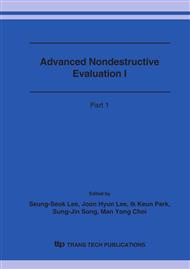p.328
p.332
p.336
p.340
p.344
p.348
p.352
p.357
p.363
Experimental Study of Sliding Load According to Changes of Axial Bolt Clamping Force of H-Beam Affected by Pure Bending
Abstract:
Despite being an important element to connect the major building materials in a steel bridge, bolt joints have not been sufficiently studied in terms of each defect generated in them. Among defects in bolt joints of steel bridges currently in public use, the most frequently occurring problem is the insufficient axial bolt clamping force. To measure sliding load caused by change in axial bolt clamping force, a test sample of H-beam applied with pure bending was created and static tests were administered. Based on the axial bolt clamping force of the test sample where the designed axial bolt clamping force is 100%, tests were carried out with different axial bolt clamping forces of 75%, 50% and 25%. Then, the sliding load caused by change in the axial bolt clamping force was analyzed.
Info:
Periodical:
Pages:
344-347
Citation:
Online since:
October 2006
Authors:
Price:
Сopyright:
© 2006 Trans Tech Publications Ltd. All Rights Reserved
Share:
Citation:


